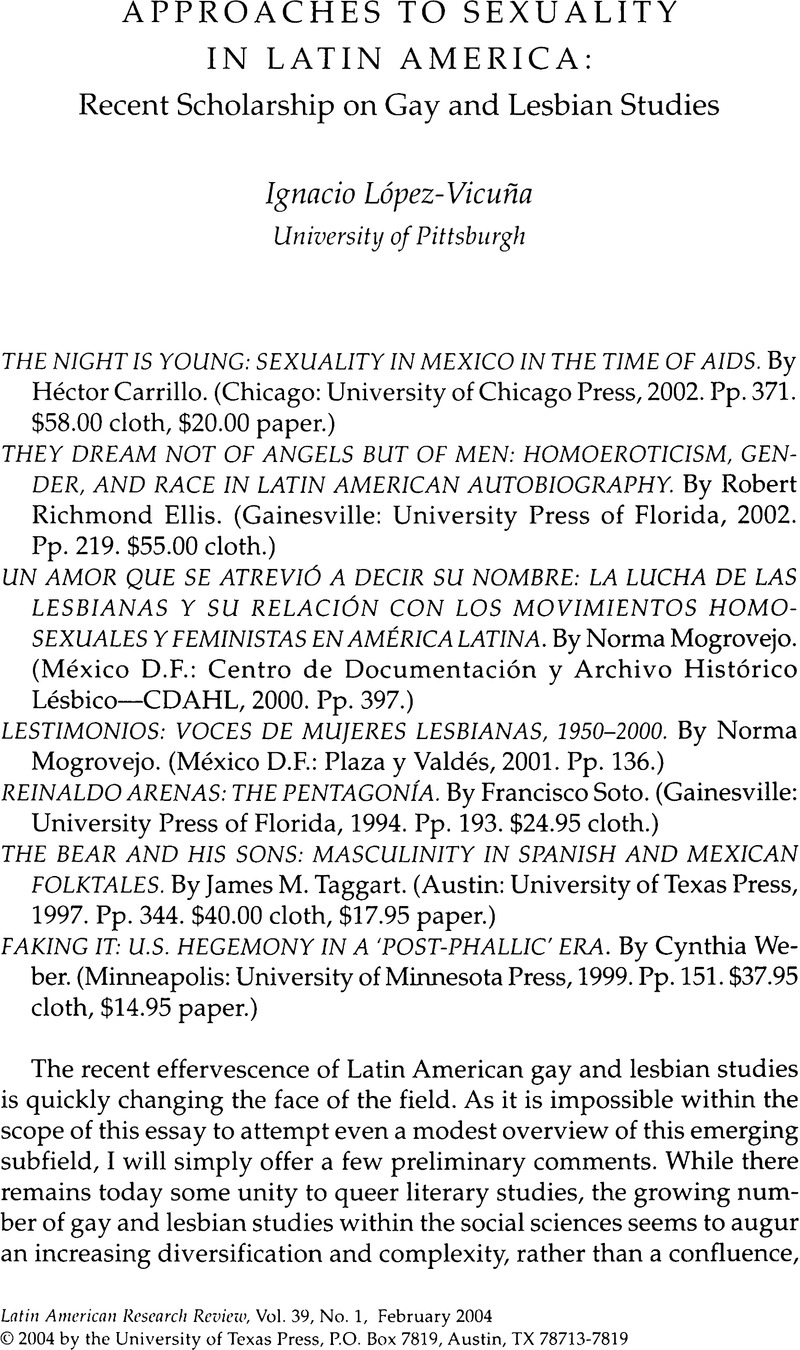Article contents
Approaches to Sexuality in Latin America: Recent Scholarship on Gay and Lesbian Studies
Review products
Published online by Cambridge University Press: 05 October 2022
Abstract

- Type
- Review Essays
- Information
- Copyright
- Copyright © 2004 by the University of Texas Press
References
1. An indispensable starting point is David William Foster, ed., Latin American Writers on Gay and Lesbian Themes: A Bio-Critical Sourcebook (Westport, Conn.: Greenwood Press, 1994). Also see David William Foster, Gay and Lesbian Themes in Latin American Writing (Austin: University of Texas Press, 1991) and Sexual Textualities: Essays on Queer/ing Latin American Writing (Austin: University of Texas Press, 1997). For studies on both Spanish and Latin American writers, see Emilie L. Bergmann and Paul Julian Smith, eds., ¿Entiendes?: Queer Readings, Hispanic Writings (Durham, N.C.: Duke University Press, 1995). See also Sylvia Molloy and Robert McKee Irwin, eds., Hispanisms and Homosexualities (Durham, N.C.: Duke University Press, 1998).
2. Necessary starting points are Daniel Balderston and Donna J. Guy, eds., Sex and Sexuality in Latin America (New York: New York University Press, 1997) and Daniel Balderston, ed., Sexualidad y nación (Pittsburgh, Penn.: Instituto Internacional de Literatura Iberoamericana, 2000). See also Revista Iberoamericana 187: Erotismo y escritura (April–June 1999), issue directed by Daniel Balderston.
3. Notably, Licia Fiol-Matta, A Queer Mother for the Nation: The State and Gabriela Mistral (Minneapolis: University of Minnesota Press, 2002), and Emilio Bejel, Gay Cuban Nation (Chicago: University of Chicago Press, 2001).
4. The pentagonía is composed of the novels Celestino antes del alba (retitled Cantando en el pozo in 1982), El palacio de las blanquísimas mofetas, Otra vez el mar, El color del ve rano, and El asalto.
5. See Francisco Soto's Reinaldo Arenas (New York: Twayne, 1998) for an excellent overview of Arenas' oeuvre. See also Esteban Montejo, Biografía de un cimarrón, ed. Miguel Barnet (La Habana: Academia de Ciencias de Cuba, Instituto de Etnología y Folklore, 1966).
6. For a useful discussion of Arenas' anti-communitarianism see Carmelo Esterrich, “Locas, pájaros y demás mariconadas: el ciudadano sexual en Reinaldo Arenas,” Confluencia 13, no. 1 (Fall 1997): 178–93.
7. Ellis mentions, for example, the particularly odious way Vargas Llosa gets rid of his Trotskyist hero in Historia de Mayta (Barcelona: Seix Barrai, 1984) by suggesting his radicalism is really a cover-up and denial of his homosexuality.
8. The critique of machismo extends from (at least) Octavio Paz's Labyrinth of Solitude (Mexico City: Cuadernos Americanos, 1950) to the novels of the ‘boom’. Especially noteworthy are Vargas Llosa's La ciudad y los perros (Barcelona: Seix Barrai, 1962) and Conversación en la Catedral (Barcelona: Seix Barrai, 1969), as well as Cuban writer Jesús Díaz's Las iniciales de la tierra (La Habana: Editorial Letras Cubanas, 1987).
9. Judith Butler, “Imitation and Gender Insubordination,” in Inside/Out: Lesbian Theories, Gay Theories, Diana Fuss, ed. (New York: Routledge, 1991), 13–31.
10. Guadalajara is significant as a modern city that is also the seat of traditional values of mexicanidad, which makes it, as Carrillo explains in his preface, an ideal case study for changing attitudes towards sex. In 1991 Guadalajara was chosen to be the site for the ILGA (International Lesbian and Gay Association) conference. Violent local opposition from conservative sectors, however, forced the meeting to be moved to Acapulco.
11. García Canclini's notion of “cultural hybridity” has been criticized because it often conceals a tendency towards synthesis, which renders it little more than a postmodern figure for “mestizaje” or “transculturation.” Carrillo's use of the term, however, seems to respond more to a need to describe aspects of Mexican culture that resist, as well as incorporate, modern ideas about sexuality.
12. Carrillo's mapping of sexual identities builds on the work of, among others, Richard Parker in Brazil and Roger Lancaster in Nicaragua, both of whom Carrillo cites. See Parker's Bodies, Pleasures, and Passions: Sexual Culture in Contemporary Brazil (Boston: Beacon Press, 1991) and Lancaster's Life Is Hard: Machismo, Danger, and the Intimacy of Power in Nicaragua (Berkeley and Los Angeles: University of California Press, 1992).
13. This is evidenced by the emergence of gay bars in Guadalajara during the 1990s, creating what Carrillo describes as a “grid of homosexual spaces and social networks that was superimposed on the nonhomosexual city” (111). Carrillo's section on urban space and gay life adds to the study of homoeroticism and urban space in Latin America. Important studies are Néstor Perlongher's ethnography of male prostitution in São Paulo, O negócio do michê (São Paulo: Editora Brasiliense, 1987), and Juan José Sebreli, “Historia secreta de los homosexuales en Buenos Aires,” in Escritos sobre escritos, ciudades bajo ciudades: 1950–1997 (Buenos Aires: Sudamericana, 1997), 275–370. Also of interest is Flavio Rapisardi and Alejandro Modarelli, Fiestas, Baños y Exilios: Los gays porteños en la última dictadura (Buenos Aires: Sudamericana, 2001).
- 1
- Cited by




